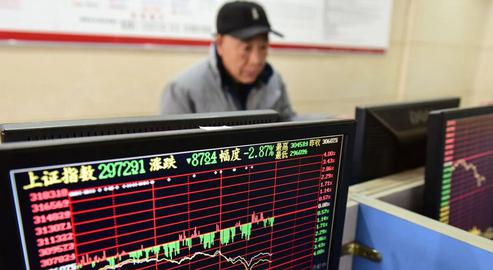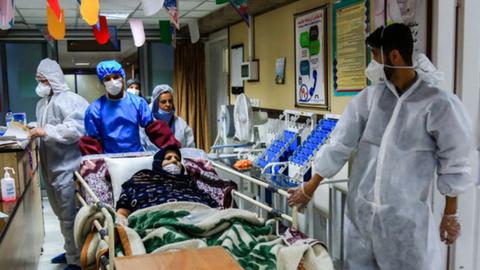What has the coronavirus pandemic done to the global economy, and specifically to Iran? The map below provides the latest growth estimates by the International Monetary Fund (IMF) for 2020; to find a previous one that resembles it, one has to go back to at least 1980. More than half of the countries in the world are now presented in red and orange, denoting an unprecedented level of negative economic growth in modern times.
This economic map, the most trusted in the world, was updated by the IMF’s experts just a few days ago. Red signifies a growth rate of less than minus 3 percent, and orange stands for a rate of 0 to minus 3 percent. According to the IMF’s estimates, the coronavirus pandemic will cause the world economy to contract by 3 percent: 7 percent in the European Union, 6 percent in America and Canada, 7 percent in Australia, 6 percent in Russia, 2 percent ibn Saudi Arabia, 6 percent in Israel, 5 percent in Turkey – and 6 percent in Iran.
China, India and Indonesia are the only large economies expected to show positive growth: China by 1 percent, India by 2 percent and Indonesia by 0.5 percent. Even these figures lose their luster when compared to what they could have been in a world without coronavirus.
This economic crisis is vastly different from those that preceded it in the 1980s and 1990s, and in 2009. The map above portrays the situation in 2009. That year, the global growth rate stood at close to zero, while that of advanced economies was around minus 3 percent. But 11 years ago, neither the depth nor the breadth of the crisis was anything like that we are experiencing today as a result of Covid-19.
We Are All in the Same Boat
This time around, the world resembles a big boat, and we all are its passengers: rich and poor, friend and foe. But the passengers are not in the same situation. Some are better-equipped to weather a storm than others. Those who had a stable economy in the pre-pandemic period will naturally survive the crisis. But countries like Iran have a very difficult road ahead.
Iran’s Fragile Economy
Earlier this year, Iran’s economic growth rate was expected to be around 2020. The pandemic has seen the revised figure plunge to minus 6 percent. A negative 6 percent growth rate would be a disaster for any country in the world. But the scale of this economic blow is not new to Iran, and the downturn this year is more devastating to Iran due to years of successive “crashes”.
In fact, according to the data in IMF’s archives, Iran’s economy has shrunk by 6 percent at least nine times since 1980. The first five severe downturns occurred in the early years after the 1979 revolution, and during the Iraq War. The other four, however, took place more recently. In 2012, at the tail end of Mahmoud Ahmadinejad’s presidency, the economy shrank by 8 percent in a year. In 2018 and 2019, Iran’s annual growth rate was minus 6 percent and minus 8 percent respectively. Now, the IMF estimates the economy will contract once again in 2020.
This means that in the past three years alone, Iran’s economy has shrunk by 18 percent. In other words, by the end of this year the country’s economy is forecast to be one-fifth smaller than it was in 2018.
Sluggish Growth and a Booming Population
The IMF’s data shows that Iran’s average economic growth between 1980 to 2020 has been a positive 1.6 percent. Presently, the economy is 1.7 times bigger than it was before the Revolution. But in the same period, the global economy grew at an average rate of 6 percent: almost twice that of Iran. Even the economies of Iran’s neighbors in Middle East have grown by just over than 3 percent in this time.
In the same period, Iran’s population more than doubled from approximately 36 million people to more than 83 million. In other words, the economic power of the Iranian people is significantly less than what it was 40 years ago. The global population, meanwhile, has not quite doubled since 1980 while the world economy is almost four times bigger than it used to be: the world’s resourcing has doubled.
These figures clearly show that compared to other countries and even to its neighbors, the Iranian economy is at a considerable disadvantage when it comes to dealing with a global social and economic crisis. Even when things return to normal, Iran has little prospect of returning to or improving on the dire situation it was in already.
Related coverage of the Coronavirus Outbreak in Iran:
Lies, Misinformation and Makeshift Graves: a Chronology of Coronavirus in Iran
Low Pay and Mounting Pressures: The Saga of Iranian Workers, 2 May 2020
The Economic Impact of Coronavirus on Single Iranian Women, 1 May 2020
Hit Hard by the Pandemic Recession, Many Iranian Day Laborers Turn to Scavenging, 29 April 2020
Making a Living on the Streets, 23 April 2020
How Many Meals Can You Buy With Emergency Aid in Iran?, 3 April 2020
Which Iranian Businesses have been Affected by Coronavirus?, 18 March 2020
Iranian High Street Businesses Suffer because of Coronavirus, 16 March 2020
visit the accountability section
In this section of Iran Wire, you can contact the officials and launch your campaign for various problems


























comments